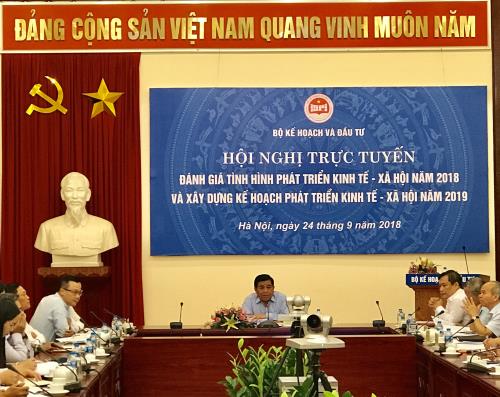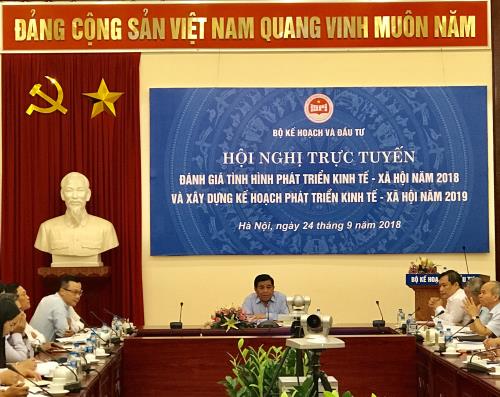
Economic restructuring should be channelled more specifically to realise the socio-economic targets set by the National Assembly, not only for 2018 but also for the following years, said Minister of Planning and Investment Nguyen Chi Dung.
At a teleconference on
September 24 with localities nationwide to evaluate the socio-economic
situation in 2018 and set up plans for 2019 (Photo: VNA)
At a teleconference on
September 24 with localities nationwide to evaluate the socio-economic
situation in 2018 and set up plans for 2019, Dung underlined that cities and
provinces should strictly implement the Government’s Resolution No.01/NQ-CP
2018 on key missions and solutions to realise the socio-economic plan and state
budget estimate in 2018.
He also laid stress on the organisation of the conference, which he described
as a breakthrough for the sector in carrying out socio-economic development
solutions in a prompt, sustainable, and effective manner.
According to Tran Quoc Phuong, Director of the National Economic Issues
Department under the Ministry of Planning and Investment, thanks to concerted
efforts made by the Government, ministries, sectors, localities and businesses
as well as support from international organisations and local people, Vietnam has
recorded positive socio-economic development in 2018.
A stable macro-economy is a remarkable achievement and was the driving force
behind the economic restructuring, as well as motivated other sectors, he said,
adding that the GDP was estimated at 6.7 percent and inflation was under
control with the consumer price index (CPI) being well maintained below 4
percent.
The financial market experienced stable progress as credit growth was curbed at
around 17 percent, meeting sufficient capital for the production and business
sector, he said.
Improvements were seen in other important indexes, for example the debt rate
fell from the 63.7 percent at the end of 2016 to around 61.4 percent this year.
State budget collection was estimated at more than 1.35 quadrillion VND (57.8
billion USD), up 3 percent from the initial forecast and 5 percent from 2017.
However, State budget overspending was reckoned at 3.67 percent, higher than
the level assigned by the National Assembly.
The teleconference also shed some light on the disbursement of public
investment and ODA, FDI attraction, the renewal of the growth model, amendments
to the Law on Public Investment, and the building of a revised planning
law.
Source: VNA
According to data from the Hoa Binh Provincial Party Committee, the industrial production index for the first six months of 2025 is estimated to have increased by 20% compared to the same period last year. This marks the highest year-on-year growth rate for this period since 2020.
In the first six months of 2025, Hoa Binh province’s export turnover was estimated at 1.145 billion USD, marking an 18.11% increase compared to the same period in 2024. Import turnover was estimated at $ 804 million, a 17.15% increase, which helped the province maintain a positive trade balance.
The lives of the ethnic minority farmers in Tan Lac district have gradually improved thanks to the new directions in agricultural production. This is a testament to the collective strength fostered through the professional associations and groups implemented by various levels of the district’s Farmers’ Union.
With the motto the "product quality comes first,” after nearly one year of establishment and operation, Muong village’s Clean Food Agricultural and Commercial Cooperative, located in Cau Hamlet, Hung Son Commune (Kim Boi district), has launched reputable, high-quality agricultural products to the market that are well-received by consumers. The products such as Muong village’s pork sausage, salt-cured chicken, and salt-cured pork hocks have gradually carved out a place in the market and they are on the path to obtaining the OCOP certification.
In the past, the phrase "bumper harvest, rock-bottom prices" was a familiar refrain for Vietnamese farmers engaged in fragmented, small-scale agriculture. But today, a new spirit is emerging across rural areas of Hoa Binh province - one of collaboration, organisation, and collective economic models that provide a stable foundation for production.
Maintaining growing area codes and packing facility codes in accordance with regulations is a mandatory requirement for agricultural products to be eligible for export. Recently, the Department of Agriculture and Environment of Hoa Binh province has intensified technical supervision of designated farming areas and packing facilities to safeguard the "green passport" that enables its products to access international markets.



